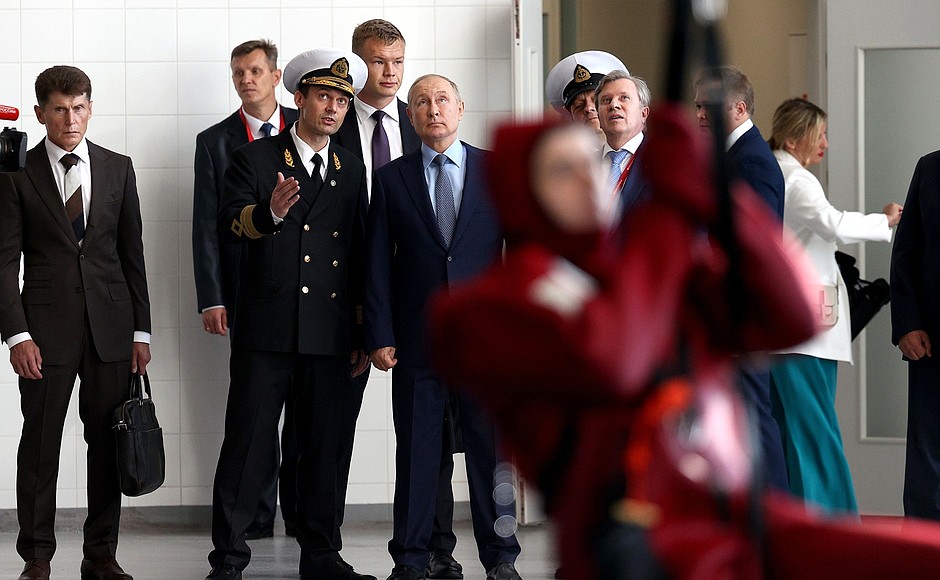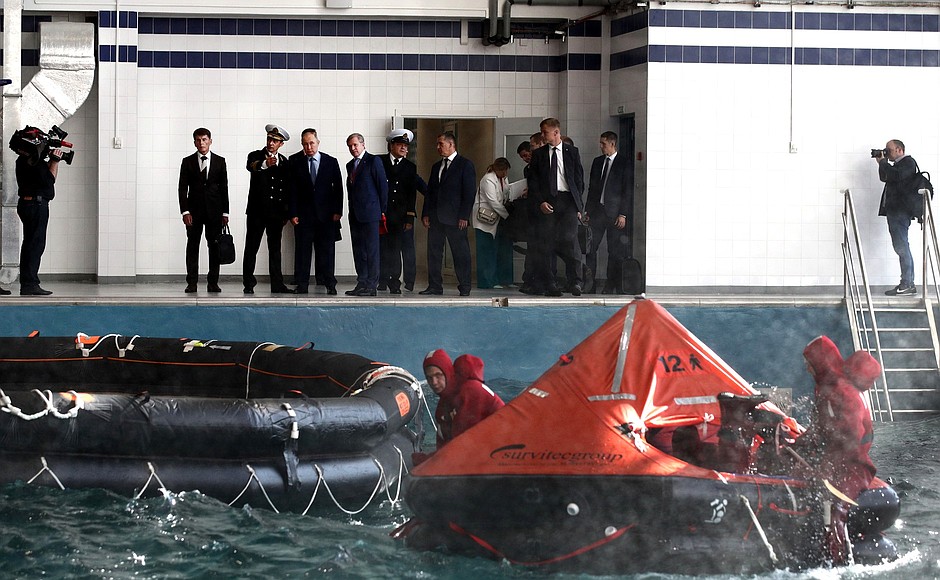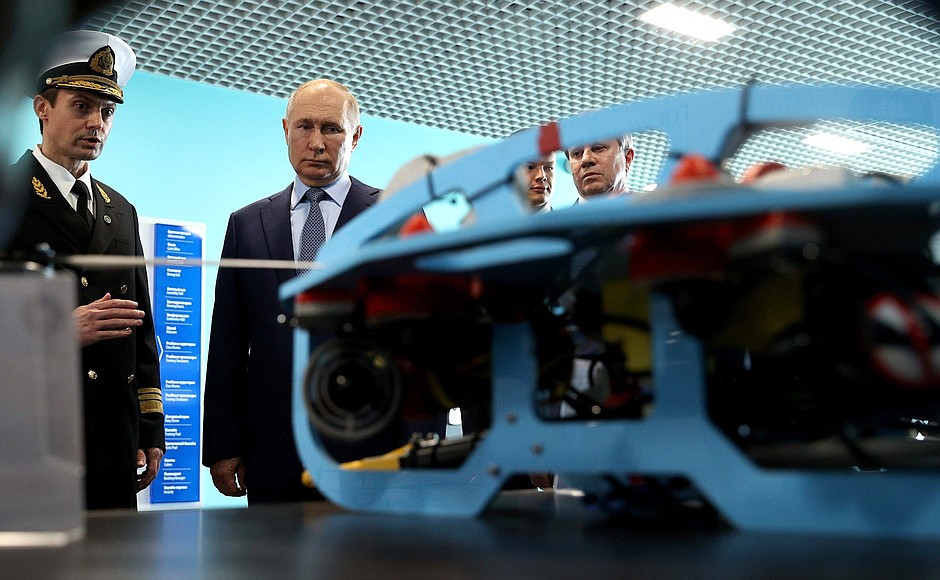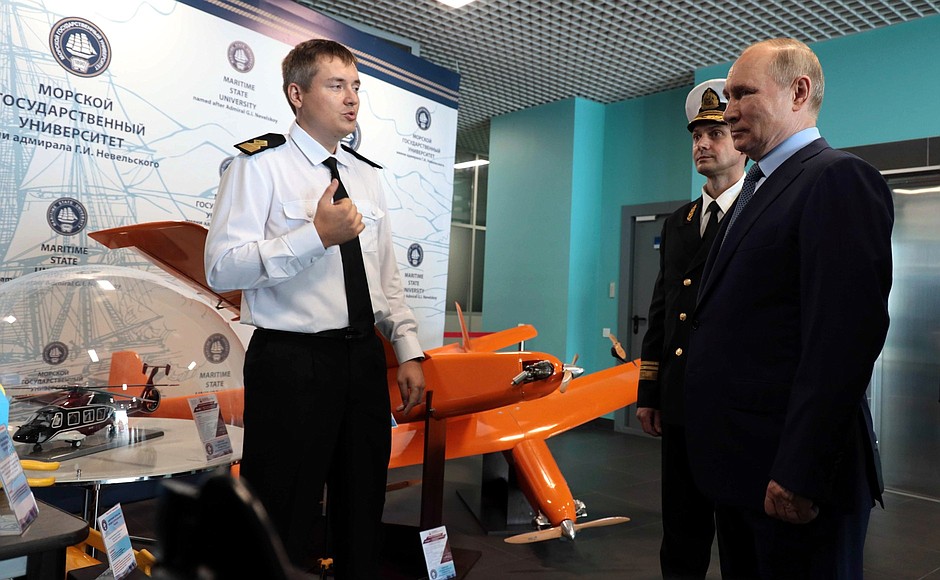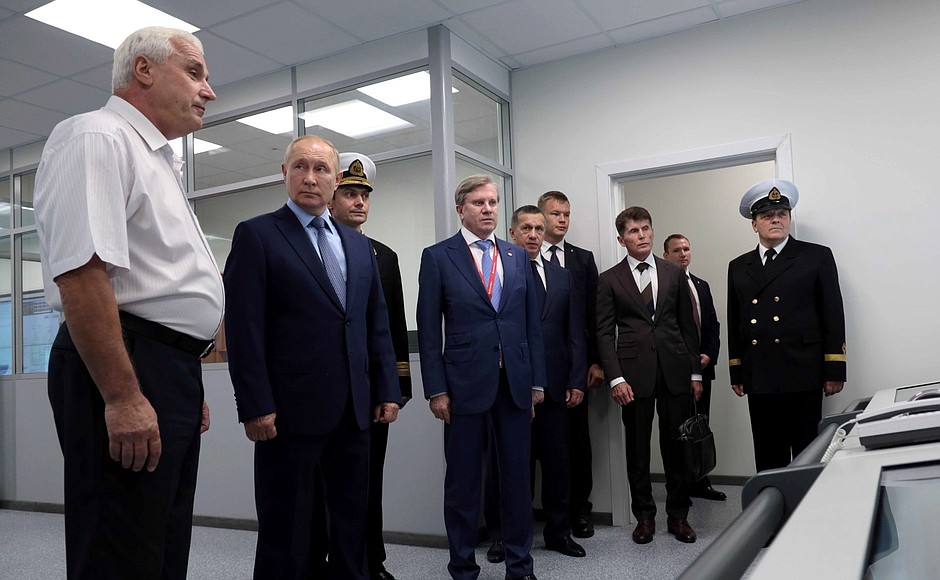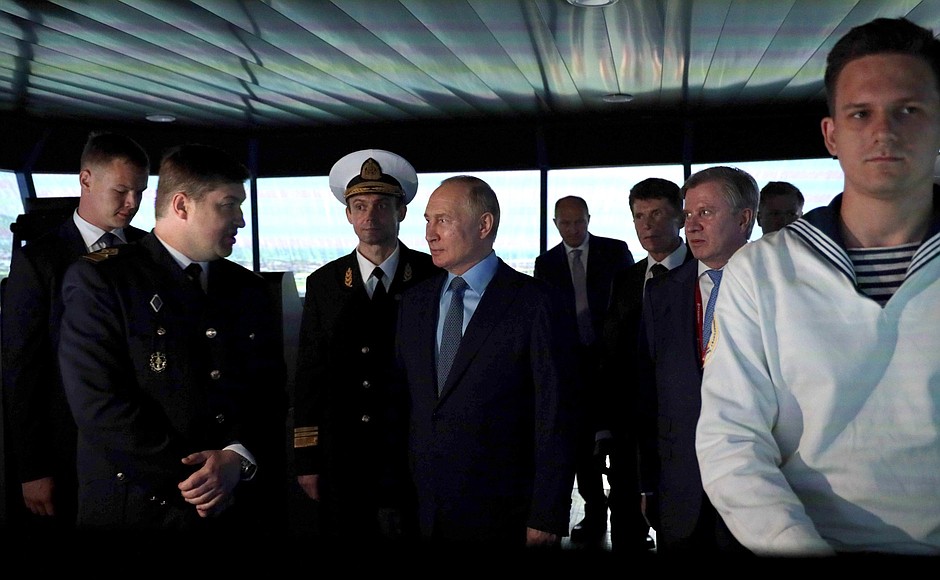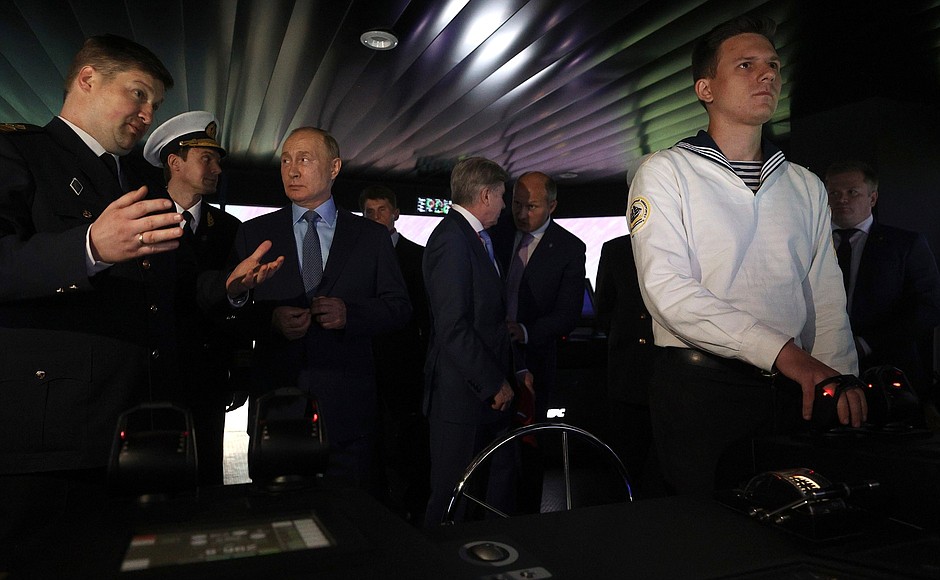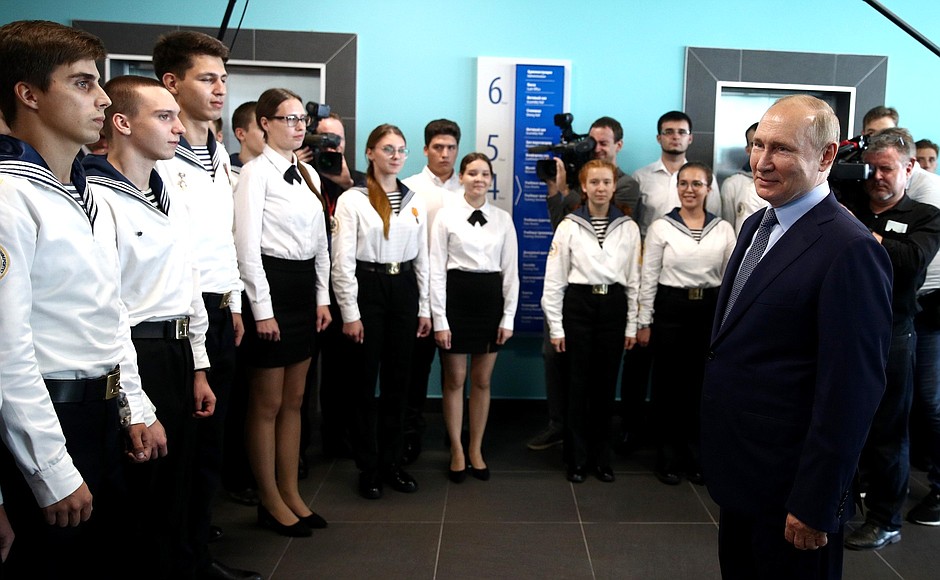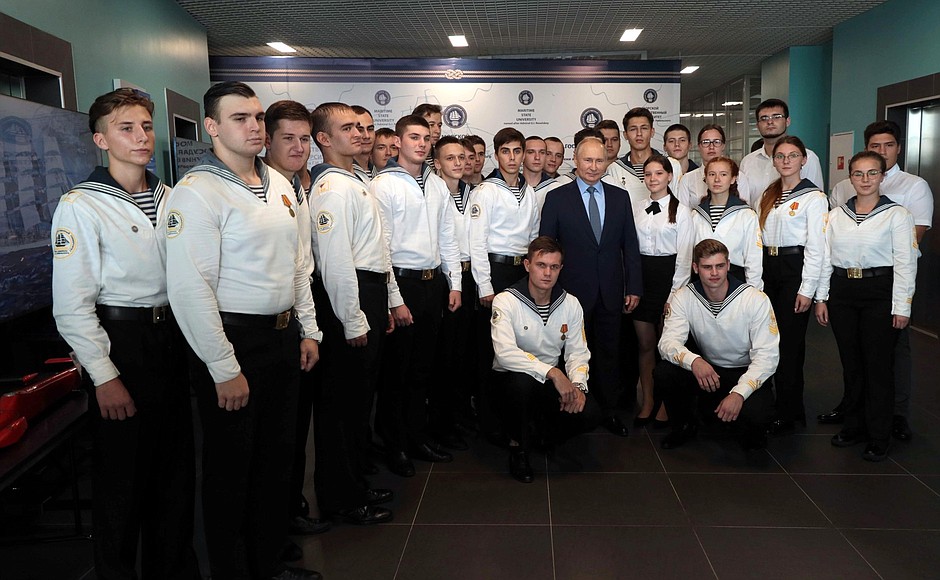The President got acquainted with the training process there, as well as with the University’s advanced science and engineering projects, and spoke with cadets.
The Training Centre that started operating in July 2021 is a unique facility for training the crews of multi-functional vessels and improving the skills of maritime specialists.
As per the President’s instruction, the Maritime State University operates a School Under Sails, the purpose of which is to acquaint young people with the history of the Far East, and to plan and conduct high-seas voyages aboard sailing boats to places linked with Russia’s glorious military history.
* * *
Excerpts from a conversation with Admiral Nevelskoi Maritime State University cadets
Vladislav Matveyev: I am a fifth-yearcadet in the Navigation Department, Vladislav Matveyev.
For us, our university is primarily the Pacific Ocean and the Northern Sea Route. We are eager to work in the northern latitudes upon graduation. Today we see how much you are doing to develop the Northern Sea Route. We see that competition between countries is growing.
Vladimir Putin: Everyone wants to be here, including some so-called extra-regional powers.
Vladislav Matveyev: What do you think about the prospects for the Northern Sea Route?
Vladimir Putin: We would not have begun developing it if there were no potential.
As you know, the climate is changing. To begin with, the duration of the navigation season is increasing. Only recently, it was limited to a month and a half. Now it is already three to four months, and some talk even about six months. When I met with your senior colleagues, one captain said he was ready to work year round. I do not know to what extent this is possible.
However, as regards the construction of our icebreaker fleet… it is the most powerful fleet in the world. Last year and this year we launched two new icebreakers: the nuclear-powered Sibir and the diesel Viktor Chernomyrdin. The Arktika icebreaker is also afloat. All in all there should be five icebreakers in the class: the Arktika, the Ural, the Sibir, Chukotka and Yakutia. Last year, in 2020, we laid the keel for a new icebreaker not far from here, at Zvezda shipyards. It is all new and the most powerful in the world. There is nothing like it anywhere. This is the Leader with a power capacity of 150 megawatts. It can lead ships through here all year long, If we had it today, it would be able to operate the whole year.
So, we have great prospects. It is no surprise that many countries want to come and work here, and use this route. You are already a specialist. You are in your fifth year, right?
Vladislav Matveyev: Yes, Sir.
Vladimir Putin: There you go. I am sure you know all about it. Cargo shipping along the Northern Sea Route considerably reduces the cost of a commodity for the end user. This is the whole point.
Meanwhile, the Arctic accounts for 18 percent of Russia’s territory, 18 percent. Therefore, it is very important for us to develop this region, to build its port, military and rescue infrastructure. The Emergencies Ministry will make steady progress here. We have now allocated additional funds, running into billions of rubles, to the Emergencies Ministry to ensure the efficient operation of rescue stations along the entire Northern Sea Route, including saving people at sea.
The volume of freight is considerable. I do not remember exactly, it may have been in 1986 when the USSR reached a peak in shipping volumes on the Northern Sea Route. It was either 6.3 or to 7.3 million tonnes. But do you know last year’s figure? It was 33 million tonnes. And the plan for 2024 is 80 million tonnes. This is an immense amount of work.
In addition to these things, we are proceeding from the assumption that we will work with everyone in a civilized manner, in line with international law as represented by the 1982 Convention and one other document.
What is the main point? The point is that a considerable part of this favourable route – favourable in terms of maritime shipping – lies in our internal waters. Ships can pass further north, but the ice conditions are different there and the going is more difficult. But if the favoured route is taken, a considerable part of it lies in our internal waters and our territorial sea. And, of course, this creates huge competitive advantages for us. But this does not mean that we are going to restrict anyone. No. We will provide convoy and piloting services and we will work with anyone who needs this, because we are interested in it.
In Switzerland, I met with our US colleagues, and we discussed this matter. They want to engage in this, to take part in this. Many Asian countries as well, India, China, and countries further south are also interested. We will work on it. So, there will certainly be enough work for all of you, especially in relation to the development of the icebreaker fleet.
Another question?
Alexander Melikhov: Yes, sir. I am Alexander Melikhov, fourth-year student, navigation department.
Mr President, we see the new Russian fleet being built at a fast pace. This gives us confidence in our future and shows that it is not for nothing that we have chosen the profession of sailor. How do you assess these prospects?
Vladimir Putin: Well, how? We just talked about this highly important route. Over the last five years, we have ordered 600 large vessels and 300, if I am not mistaken, have been built. Russia is a major naval power. Oceans, seas… Maritime cargo shipping is growing.
I have just spoken to the Minister and he told me how maritime shipping was growing. We will continue to encourage this in the future.
There are many job opportunities for those who love the sea and have committed their future to the sea: freight transport, passenger carriage, scientific research, the fishing fleet, etc. There are many career areas and each will be developed. It will be interesting, and there will be enough work for everyone. The maritime element is interesting. You must know this better than I do.
I wish you all the best.
